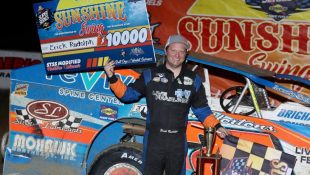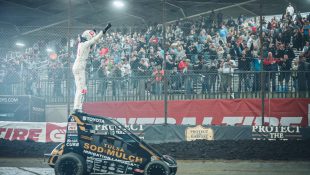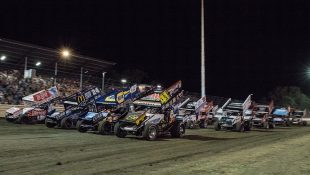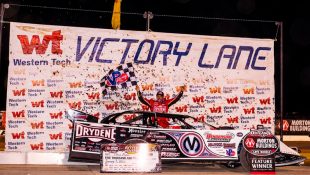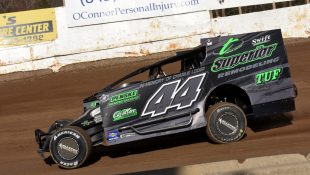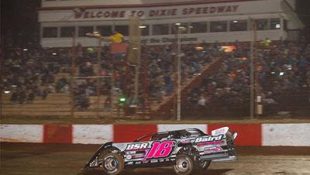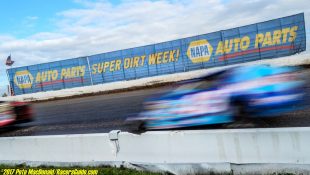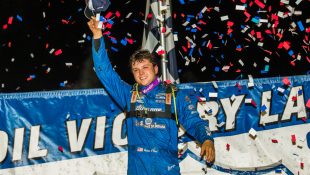FAQs and Revision to New Unified Dirt Late Model Specs
Story By: CHRISTINA CORDOVA / WRG MEDIA
Photos By: THESPORTSWIRE.NET / RACERSGUIDE.COM
 CONCORD, N.C., – November 24, 2016- As the new Unified Dirt Late Model specs released on November 9 have been reviewed by the industry, questions – as with any change – have been presented. To help answer some of the preliminary questions and usher in refinements and adjustments to the rule package, DIRTcar Racing has released the below addendum and “Frequently Asked Questions” (FAQs) document.
CONCORD, N.C., – November 24, 2016- As the new Unified Dirt Late Model specs released on November 9 have been reviewed by the industry, questions – as with any change – have been presented. To help answer some of the preliminary questions and usher in refinements and adjustments to the rule package, DIRTcar Racing has released the below addendum and “Frequently Asked Questions” (FAQs) document.
DIRTcar Racing will officially adopt the Unified Dirt Late Model Council’s technical and driver personal protection specifications, adding them to the rule books for the World of Outlaws Craftsman® Late Model Series, DIRTcar Late Models and DIRTcar Pro Late Models, effective January 1, 2017.
In addition to the outlined technical and driver personal protection specifications, the Council will meet at PRI in December to address weighted suspension components, rear end construction materials and axels.
DIRTcar Racing and World of Outlaws continue to work with their partners to ensure the safety and consistency of its cars and drivers, and to solidify the sport in all its facets.
Frequently Asked Questions
 Unified Dirt Late Model Specs
Unified Dirt Late Model Specs
Q. What is the purpose of these rules?
A. The Unified Late Model Council identified several areas where products and industry knowledge should be applied to late model racing.
Q. What is the timetable?
A. All the specifications on the bulletin will be effective for the 2017 season. Starting with the first events.
Q. What happens if we don’t have the item?
A. Compliance is expected.
Q. Where do I get all this stuff?
Parts Suppliers, Chassis Builders, Online Suppliers and many vendors have already circulated product information. The builders and suppliers have knowledge of all the products included. Many have been on the market for years and are common in short track racing.
Seats:
 Q. How do I know if my seat is compliant?
Q. How do I know if my seat is compliant?
A. The best resource for that answer is the seat manufacturer. They know the type and design of their products. They will also know if replacement or modification is required.
Q. What is “full containment”?
A. Again, the manufacturer of your seat will know this answer. Some manufacturers have kits that may be used to bring a seat into compliance. General description includes Design shall include comprehensive head surround, shoulder and torso support system, energy impact foam, and removable head foam.
Q. Can I use the seat I have?
A. The goal of this specification is enforce a full containment with comprehensive head surround, shoulder and torso support system, energy impact foam, and removable head foam head surround, upper body support and overall strength. The seat builders know exactly what will work. If applicable, upgrade kits and bolt on components may work with your base seat. The seat builders know the answer.
Q. I am a really big guy…. Containment seats won’t work. What can I do?
A. Several of the seat companies and safety companies offer an acceptable alternative to the left side head surround. The surround is supplemented with a net that attached to the seat and roll cage. Keep in mind this is left side only and needs to be installed correctly. A “latch” version of the surround has also been developed.
Fuel, Fuel Cells, Fuel Systems:
 Q. What is the Fuel Cell requirement?
Q. What is the Fuel Cell requirement?
A. There is a huge difference in fuel cell construction. The FT3 specification is the industry-accepted minimum. Your chassis builder or parts supplier will know if the cell is compliant.
Q. Can I tell the cell is compliant by looking at it?
A. There are some easy references; the easiest is the stamping near the manufacturers name. The fuel fill plate, pick-up and return will all be on the top and the container will be filled with foam.
Q. Where do I get one if mine is not and what should a new cell cost?
A. Every Chassis builder or parts supplier including the online companies offer a dirt late model FT3 approved cell.
Q. Can I make my current cell compliant?
A. Most likely no. You will need to replace a non-compliant cell. Your parts supplier can help you with that… as important as the fuel cell is…. Holding gallons of a highly flammable fluid… is this the right place to not get the best??
Q. What are the straps?
A. Your chassis builder most likely has these installed. If they are not in place they will have an add-on kit to secure the cell to the chassis.
Electrical Systems, Batteries, Electrical Accessories:
Q. What about the battery?
A. Make sure your battery is securely mounted by brackets. Also make sure the posts are covered to prevent any thing from crossing the posts and creating a spark. You do not want your battery flopping around or held by a bungee.
Q. Shut Off? What is that for?
A. First, it’s a great way to shut the electrical system down on your car but more importantly it allows track safety to deaden the electrical system to prevent sparking, arching or engine run on. There are several options available including marine shut offs.
Wheel, Wheel Discs, Wheel Spacers:
 Q. Why?
Q. Why?
A. There are incidences of wheel covers coming off and flying into spectator areas. Other than maybe saying, “where did my wheel cover go?” a driver seldom sees the result of the flying wheel cover.
Replacing the 3 Zeus fasteners with bolts will be easy with kits that are now being produced. You can still use the same ring and cover.
Kits are available from many of the usual vendors now.
Personal Safety Equipment:
Q. Gloves
A. Easy… great Christmas gift. An SFI Approved drivers glove is required.
Q. Head and Neck device.. we are just short track racers. Do we really need it?
A. The science is clear. The device has proven its value over and over. It doesn’t matter how fast… or type of car, size of driver, type of seat. Another great Christmas gift!
There are several options of approved devices to accommodate your situation.
Fire Suppression
Q. This is expensive and complicated?
A. Yes, this system requires a driver’s investment and is something we have gone too long without. There are several approved systems available and we encourage you to shop for the one that meets your car and position.
Several companies have a kit available specifically for DIRT Late Models meeting these specifications.
Thank you for your support of dirt late model racing. The true benefactors of all these specifications are the participants and their families.
Updated November 22, 2017 Rev.4
THIS DOCUMENT IS INTENDED AS A GUIDE TO THE UNIFIED LATE MODEL COUNCIL RULES, RULE ADJUSTMENTS, RULE ADDITIONS, REFINEMENTS, AND ADDENDUMS.
Please note: The bullet points of this bulletin will be applied to each Series’ individual rule book, amending the applicable rule section or in some cases creating a new section.
Also note the revision to the seat requirement, highlighted in red below.
For additional information regarding seats and the other specifications, review the FAQs above.
LATE MODEL TECHNICAL BULLETIN
Effective January 1, 2017
Fuel, Fuel Cells, Fuel Systems:
•An approved fuel cell must be used at all times.
•The only fuel cells that are approved are those that meet and/or exceed the FIA / FT3 specifications.
•Fuel cells must be used in accordance with the FT3 specifications. Alterations of any kind will not be permitted. (Example: alterations to top plate, alterations or removal of foam, etc.)
•Fuel valve plate, fuel pickup and fuel return fittings must be on the top of the fuel cell.
•Fuel cells that are not contained within a welded steel tubing “rack” must have two (2) equally spaced steel straps that measure two (2) inches wide by 1/8 inch in thickness that completely surround the fuel cell. The straps must be bolted to the frame. Longitudinal (front to rear) orientation is recommended for strap mounting.
•Willy’s Carburetor roll over plate part # WCD4000 is approved for competition.
Electrical Systems, Batteries, Electrical Accessories:
•The battery must be securely mounted with positive fasteners and brackets.
•The battery terminals must be insulated or enclosed with a non-conductive material that will prevent contact with any part of the race car should the battery become dislodged from the battery mount.
•One (1) mandatory battery disconnect switch must be installed on the rear deck, behind the driver seat, in a location that is easily accessible from outside the race car. The switch must be clearly labeled with off/on direction. The switch must be directly in-line with the NEGATIVE battery cable and be capable of completely disconnecting the NEGATIVE terminal of the battery from the race car. Negative or “ground” wiring connections must not be made anywhere from the battery negative terminal to the input side of the disconnect switch. An additional battery disconnect switch within the drivers reach may also be used.
Wheel, Wheel Discs, Wheel Spacers:
•Only aluminum wheels will be permitted.
•Only approved wheel discs will be permitted. Approved wheel discs are wheel discs that are fastened to the wheel using a minimum of three (3), 5/16 inch diameter magnetic steel hex head bolts. The use of wheel discs with any other type of fastener will not be permitted.
•Only aluminum wheel spacers will be permitted.
Personal Safety Equipment:
•Drivers must wear gloves at all times they are on track, during practice and competition.
•Driver’s gloves must meet or exceed the SFI 3.3 specification and have a legible and valid SFI 3.3 label.
•Drivers, at all times they are on the track, must have their helmets correctly (following manufacturers installation and use instructions) connected to an approved head and neck restraint. The head and neck restraint must be SFI 38.1 approved and display a legible and valid SFI 38.1 label.
Race Car Installed Safety Equipment:
A. Seats
•All seats must be full containment type constructed of aluminum to the general design specifications of SFI Seat construction standards. Design shall include comprehensive head surround, shoulder and torso support system, energy impact foam, and removable head foam.
•SFI certification, for dirt late model seats will be developed with compliance timetable released when available.
•Up fitting a current seat with bolt on kits will be permitted with a seat manufacturer produced kit and an acceptable base seat approved by the seat manufacturer. Components must include comprehensive head surround, shoulder and torso support system, energy impact foam. Must be installed in accordance to seat manufacturer instructions. Combining components may not meet future SFI Certification when released.
•Seats must be used as supplied and installation following instructions provided by the seat manufacturer. An exception of trimming the length of the left side head surround for the purpose of egress may be approved. If the left side head surround is trimmed to a distance that is less than the most forward surface of the drivers helmet (usually the area crossing the chin) then a left side head net meeting the SFI 37.1 must be installed with a quick release latch.
•Seats must be mounted to a seat frame that is welded to the racecar frame/roll cage structure. Attaching points, angles, and materials for the seat frame and mounting of the seat to the seat frame must be in accordance to the seat manufacturer instructions.
B. Fire Suppression
•All racecars must be equipped with a thermally deployed automatic fire suppression system. The fire suppression system will consist of a DOT approved cylinder manufactured from aluminum or steel with a capacity of ten (10) lbs. of fire extinguishing agent, steel or steel reinforced lines, and two (2) thermally activated discharge nozzles.
•All systems must meet or exceed SFI 17.1 specifications.
•Systems must be fully charged with ten (10) lbs. of DuPont FE-36, 3M NOVEC 1230, or Fire Aide and display a legible and valid SFI and manufacturer label depicting fire extinguishing agent, capacity, and certification date. Cylinders that or beyond useful certification date must be inspected, serviced and re-labeled by the manufacturer.
•Cylinders must be mounted forward of the fuel cell. Cylinders must be securely mounted to the frame/roll cage assembly. The certification label must be unobstructed and easily accessible for inspection when the mounting is complete.
•The cylinder must be connected to the nozzles with steel or steel reinforced lines.
•Two (2) thermally activated nozzles must be used. One (1) nozzle must be located directly above the fuel cell in the fuel cell area and the second nozzle must be located in the driver cockpit area.
•An optional manual override cable may be added to the system.
As agreed by the Unified Late Model Council November 5, 2016 rev.3; updated November 22, 2017 rev.4

DIRTcar Racing is brought to fans by many important sponsors and partners, including: Hoosier Racing Tire (Official Tire), VP Racing Fuels (Official Racing Fuel), Chevy Performance Parts and NAPA Auto Parts; in addition to contingency sponsors, including: ASI Race Wear, Bicknell Racing Products, Bilstein Shocks, Cometic Gasket, Comp Cams, Edelbrock, Fox Shocks, Henry’s Exhaust Systems, Intercomp, JE Pistons, JRI Shocks, KSE Racing Products, Mike’s Racing Heads, Motorsports Safety Systems, MSD, Pole Position Raceway, Superflow Dynos and Wrisco Aluminum; along with manufacturer sponsors, including: Beyea Headers, Racing Electronics and TNT Rescue.



